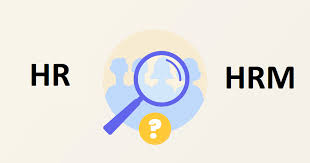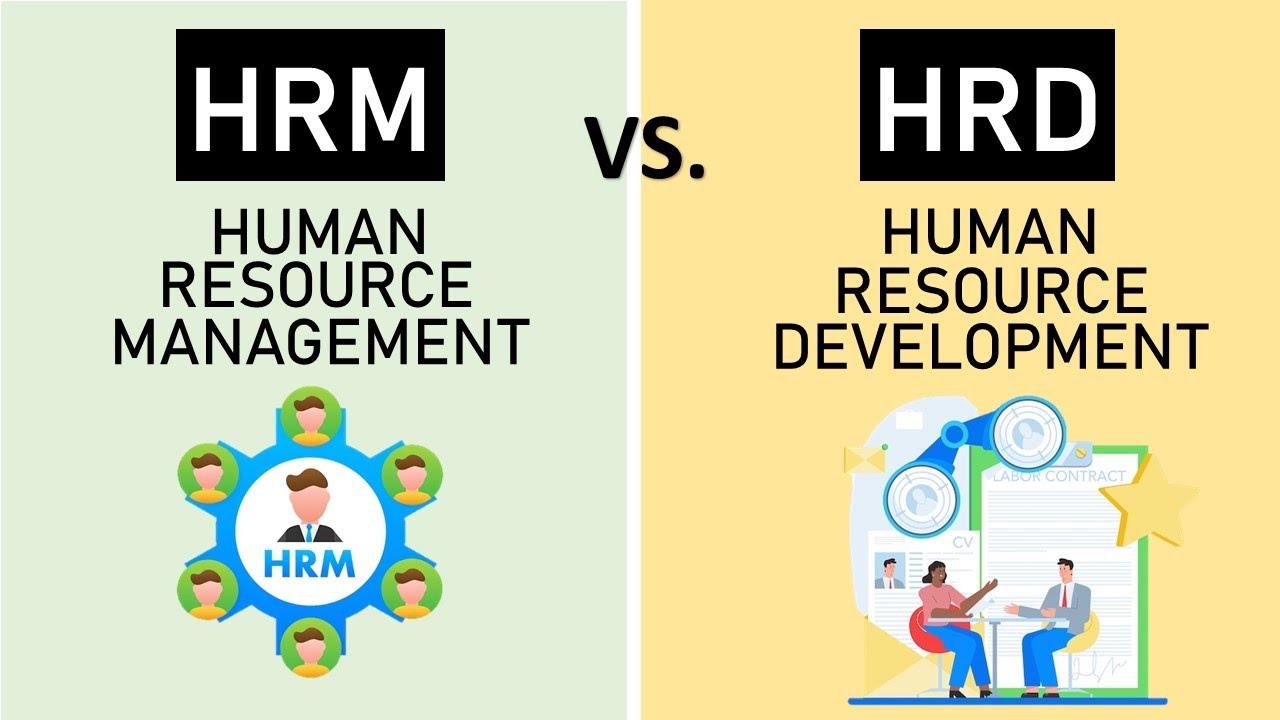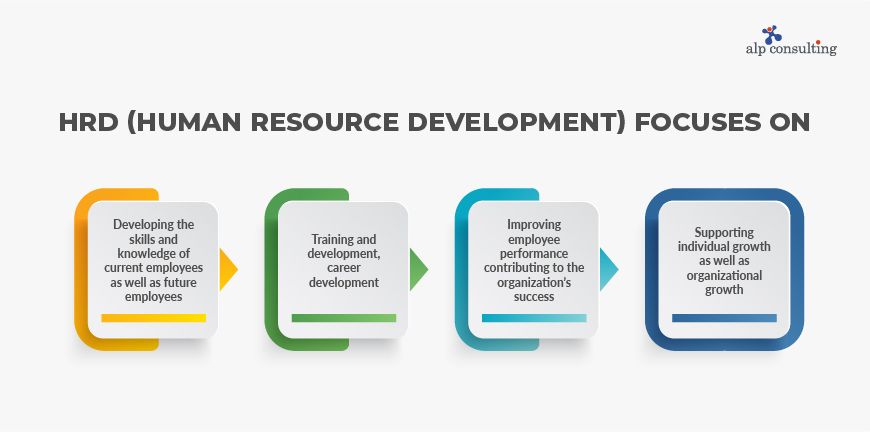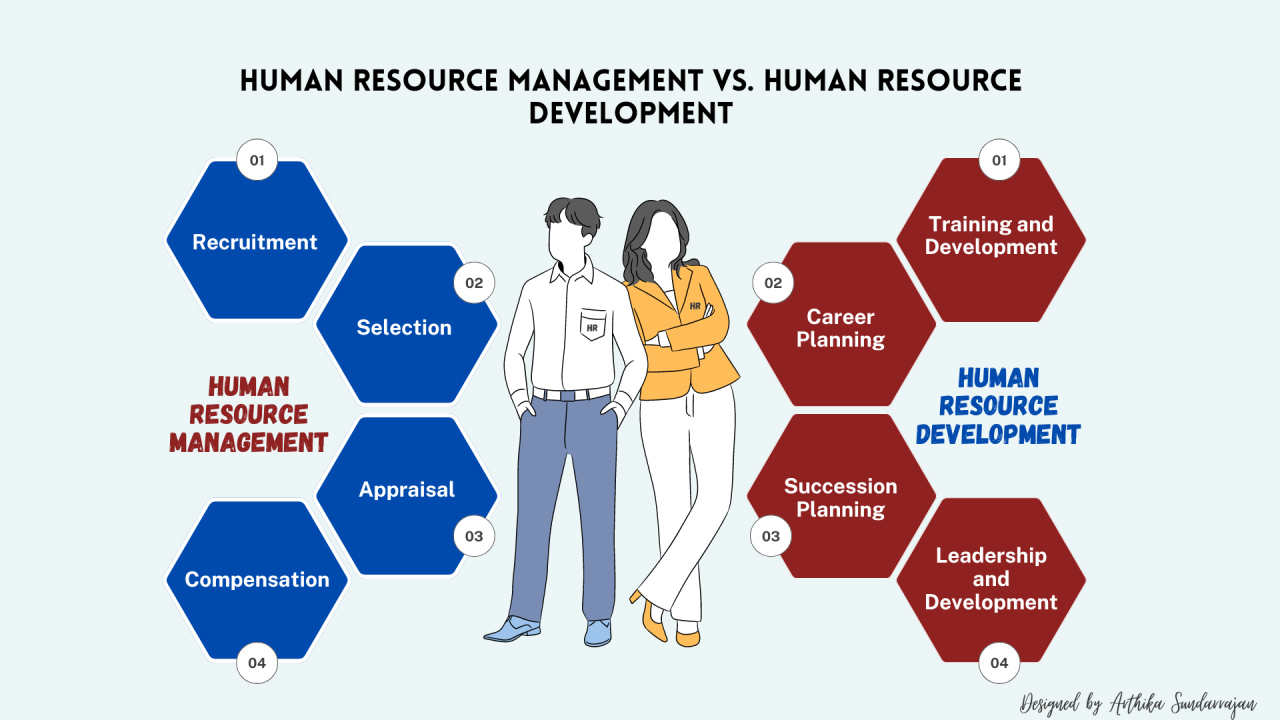
How can we help you today?
Registered Office
Infowan Technologies Pvt Ltd
Mumbai-401107. INDIA.
Contact Details
+91 98201 97205
+91 98201 26871
+91 98670 74415
support@infowan.net
info@infowan.net
|
Table of Contents
|
|---|
| Introduction: Why HRM and HRD Differences Matter |
| What is HRM (Human Resource Management)? |
| Core Functions of HRM |
| Example of HRM in Practice |
| What is HRD (Human Resource Development)? |
| Core Functions of HRD |
| Example of HRD in Practice |
| Key Differences Between HRM and HRD |
| How HRM and HRD Work Together |
| Why Understanding the Difference Matters |
| Common Mistakes Businesses Make |
| Implementing HRM and HRD Effectively |
| Conclusion: Balancing HRM and HRD |
| FAQs |

Understanding the difference between HRM and HRD is essential for any organization looking to achieve operational efficiency while promoting long-term employee growth. HRM (Human Resource Management) focuses on administrative functions like recruitment, payroll, and compliance, whereas HRD (Human Resource Development) emphasizes employee learning, skill enhancement, and career development.
Many organizations mistakenly use HRM and HRD interchangeably, which can lead to ineffective resource allocation, lower employee engagement, and missed strategic growth opportunities. By understanding the difference between HRM and HRD , businesses can design HR strategies that balance daily operations with talent development.
In this comprehensive article, we will explain the core functions, objectives, and key distinctions between HRM and HRD, demonstrate how they complement each other, and provide practical guidance for effectively managing human resources.
Human Resource Management (HRM) is the process of managing people in an organization to achieve business objectives efficiently. HRM ensures that all administrative and operational aspects related to employees run smoothly while supporting organizational goals. Companies using HR software can streamline employee data management and compliance tracking.
Recruitment and Selection: Attracting, hiring, and onboarding qualified talent.
Payroll and Compensation Management: Ensuring accurate and timely salary disbursements, bonuses, and benefits using modern payroll software
Compliance: Adhering to labor laws, regulations, and internal policies.
Employee Relations: Managing workplace conflicts, grievances, and engagement initiatives.
Performance Monitoring: Tracking employee performance to ensure productivity and operational efficiency.
HRM primarily focuses on short-term objectives and operational efficiency, ensuring that employees are effectively managed and organizational policies are properly implemented. By using HR technology, such as InfowanHR, HR teams can automate routine tasks like attendance tracking, payroll processing, and leave management, allowing managers to focus on strategy and employee engagement.
Example:A company using an HRM system can process payroll for hundreds of employees accurately each month while ensuring compliance with labor laws and company policies. Implementing a robust payroll management systemfurther reduces errors and saves time.

Human Resource Development (HRD)is the process of enhancing employees’ skills, knowledge, and abilities to foster personal growth and organizational success. Unlike HRM, HRD is long-term and focuses on developing talent to meet future organizational needs.
Training and Development: Conducting workshops, online courses, and programs to enhance skills.
Career Development: Creating personalized growth paths and mentorship programs.
Succession Planning: Identifying and preparing future leaders within the organization.
Talent Engagement: Encouraging innovation, creativity, and motivation among employees.
Performance Improvement: Providing coaching and learning opportunities to improve productivity and career growth.
HRD emphasizes proactive strategies and long-term objectives aiming to create a workforce capable of adapting to evolving business needs. Organizations that invest in HRD ensure that employees are engaged, skilled, and prepared for leadership roles.
Example: A company implementing HRD programs may offer specialized training for employees to develop digital skills, leadership abilities, or cross-functional expertise, ensuring alignment with future organizational goals. Using employee management systems helps track training progress and growth metrics effectively.
The difference between HRM and HRD can be summarized through their focus, approach, and activities. Instead of a table, here’s a detailed bullet-point comparison:

Focuses on administration and policy enforcement.
Works with short-term objectives, managing day-to-day operations.
Adopts a reactive approach, addressing problems as they arise.
Activities include payroll management, recruitment, attendance tracking, compliance, and employee relations.
Many organizations now use employee management systems to monitor workforce planning and optimize talent allocation.

Focuses on learning, development, and long-term growth.
Works with long-term objectives, preparing employees for future challenges.
Adopts a proactive approach, anticipating skill gaps and growth needs.
Activities include training programs, mentorship, career planning, succession planning, and talent development.
Understanding the difference between HRM and HRD is essential for organizations to ensure that operational efficiency does not come at the expense of employee growth and skill development.
HRM and HRD are distinct but interconnected components of human resource strategyWhen combined effectively, they ensure organizational success and a high-performance culture.
HRM handles administrative efficiency: payroll, attendance, leave, compliance, and employee relations.
HRD drives employee development: training, mentoring, career advancement, and engagement initiatives.
Together, HRM and HRD create a synergistic effect: balancing operational management with skill growth.
Example: Using a comprehensive HRMS like InfowanHR, organizations can integrate payroll and attendance management with performance tracking and training programs, ensuring employees are both efficiently managed and continuously developed.

Recognizing the difference between HRM and HRDoffers multiple benefits:
Optimized Resource Allocation: HR departments can balance administrative tasks with employee development initiatives.
Enhanced Employee Engagement: Employees feel valued when their growth and development are prioritized alongside operational management.
Strategic HR Planning: Aligning HRM and HRD ensures that workforce planning supports long-term business goals.
Business Growth: Organizations can achieve both operational excellence and sustainable talent development.
Without understanding this difference, businesses risk inefficiencies, employee dissatisfaction, and lost opportunities for growth.
Many organizations fail to recognize the difference between HRM and HRD , resulting in common pitfalls:
Treating HRM and HRD as interchangeable processes.
Overemphasizing administrative efficiency while neglecting employee development.
Ignoring data-driven decision-making in HR planning.
Failing to integrate HRM and HRD strategies, causing gaps in workforce development.
Not investing in training programs or career development initiatives, leading to low retention.
Avoiding these mistakes ensures a balanced HR strategy that benefits both employees and the organization.
To implement HRM and HRD effectively, organizations should focus on:
Leveraging Technology: Automate payroll, leave management, and attendance tracking.
Tracking Performance: Use metrics to identify skill gaps and target development initiatives.
Creating a Balanced HR Strategy: Ensure administrative efficiency while supporting employee growth.
Continuous Evaluation: Regularly assess HR policies and training programs to align with organizational goals.
Example: InfowanHR integrates HRM and HRD processes into one platform, allowing organizations to manage attendance, payroll, and leave alongside training and career development initiatives, improving overall efficiency and employee satisfaction.
The difference between HRM and HRDlies in their focus and purpose. HRM emphasizes administration, compliance, and operational efficiency, while HRD focuses on employee growth, skill enhancement, and long-term development. Understanding and integrating both functions allows organizations to maintain smooth HR operations while fostering a culture of continuous learning and development.
By effectively balancing HRM and HRD, companies can maximize productivity, retain talent, and achieve strategic growth.
Book a Free Demo and see how we can help you balance HRM and HRD seamlessly.
Q1. What is the main difference between HRM and HRD?
HRM focuses on administrative tasks and operational efficiency, while HRD focuses on employee development and long-term growth.
Q2.Can HRM exist without HRD?
Yes, but without HRD, employees may lack skill development, innovation may decline, and future growth could be limited.
Q3.Is HRD only about training?
No, HRD includes training, mentorship, career development, and succession planning.
Q4.How do HRM and HRD complement each other?
HRM manages administrative tasks efficiently, while HRD enhances employee skills and engagement, creating a high-performance organization.
Q5. Why is understanding the difference important?
It helps organizations allocate resources effectively, boost engagement, and align HR strategy with business objectives.
Q6. Which is more critical for business success: HRM or HRD?
Both are essential; HRM ensures smooth operations, and HRD prepares employees for long-term growth.
Q7.How can technology help integrate HRM and HRD?
Platforms like InfowanHR streamline both administrative and developmental HR processes, enabling efficiency and growth.
Q8. How often should HRD programs be conducted?
HRD programs should be ongoing, based on skill gaps, employee needs, and organizational goals.
Best HR Software in India | Top HR Software in India | What is an HR System? | Online HR Management Software | Best Payroll Software in India | Employee Payroll Management System | What is a Payroll System? | What is Payroll? | What is HRMS? | What is HR Management? | 7 Roles of HRM | What is Human Resources? | Top HR Interview Questions | What is HR? | HR Analytics Explained | What is HR Compliance? | Human Resource Management Guide | Best HRMS System | HR Management System Software | HR Software for Small Business | Best HRMS Employee Self Service | What are the Functions of HRM | Functions of HRM | Human Resource Accounting | Difference Between HRM and HRD | Best HRMS Software in India | Top HRMS Software in India | HRMS Companies in India | What is 3rd party payroll | Payroll Software list | What is payroll management in HR